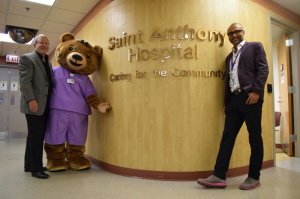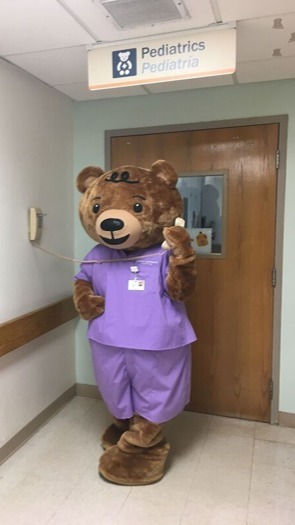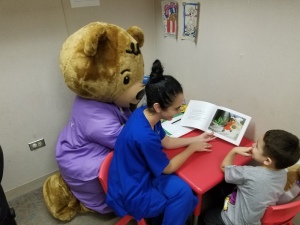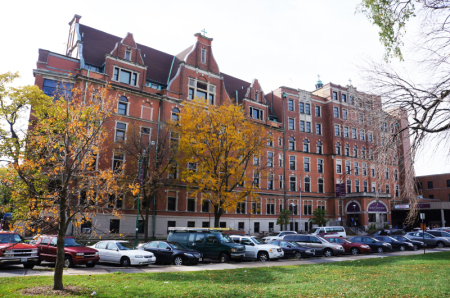Q&A with Guy Medaglia, president and CEO of Saint Anthony Hospital
November 06, 2018
by Sean Ruck, Contributing Editor
HCB News interviewed Guy Medaglia and put the spotlight on Saint Anthony in May 2017. The hospital has the honor of being the first to get a return visit to hospital spotlight due to its announcement of being officially designated a children’s hospital in July of this year. With more of a story to tell, Medaglia welcomed another conversation and started with an explanation of why Saint Anthony took the step of getting the designation.
HCB News: Why did Saint Anthony decide to pursue pediatric designation?
Guy Medaglia: We’ve seen a number of hospitals close down their pediatric department. We can’t do that – we can’t and we won’t. The communities we serve have a lot of babies, a lot of kids. When you’re a community hospital – at least what our philosophy is here – you take a snapshot of the community, review its needs and provide quality services.
I went to the state to talk about the commitment we were planning to make, but we wanted to get some kind of designation. The state agreed. We approached them having pediatric intensivists; a partnership with the University of Chicago to have residents come in. We also had partnerships in place with pediatric specialists who come to the hospital and have clinics. Through the partnerships, our patients have exposure to every specialty at the University of Chicago. If we can’t handle a specific illness, we talk with the family and recommend they go to the University of Chicago. That partnership has been very good. When we went into that partnership, we also went into a partnership with labor and delivery. They provide a lot of specialists that come here, including a maternal fetal medicine specialist. That program was working well, so they came back and asked if there was anything else we would need. We talked to them about orthopedics. So about three months ago, we started having six orthopedic specialists come in every week for clinics and services. Then, Northwestern approached us, they wanted to talk to us about some programs.
I was just telling someone the other day who had asked if we were thinking about having someone buy us. I told them we have no desire to be purchased. The model we found works for us is being independent, and lets us readily adapt to the community need without having to have the focus so strongly on financials.
HCB News: I know you’ve had a great history of fiscal responsibility during your time running the hospital, so I’m sure you’ve had a handle on getting officially designated as a children’s hospital. Were there any moments where you had concerns or any speedbumps that slowed you on the way?
GM: The state was pretty good about it. Honestly, what made a difference – when the state started to see in the Chicago area multiple hospitals closing their pediatric department, the timing was right. Our chairman of pediatrics is also an intensivist and that helped. When we told the state of the partnership with University of Chicago and they talked with the university about what the model was, the university told them it was a new day and that sometimes, you have to go out to the people. By having this partnership, it allows the university to go out into the community.
HCB News: How long were you in planning for that process?
GM: We started working with the University of Chicago first. Before we went to the state, we wanted to make sure we had almost a vertically integrated model. The chairman of that department and ours worked very closely to make sure it was a vertically integrated process. It was at least eight months that we had been working together prior to going to the state. We felt we had a good history to back us too. Since 2010 we’ve been independent. With the exception of one year where the governor hadn’t put together a budget and no one got paid and had to write a loss, every year since 2008 we’ve reported positive earnings. But we’ve evolved. We went to the community to learn what their needs were, put out RFPs to partners. Some worked, some didn’t. The partners we work with now don’t ask what the patient’s insurance is – they ask what the medical issue is. We explain it, transfer it over. Those are great partners, those are partners that want to be part of the community.
HCB News: What did Saint Anthony’s need to do to get that designation?
GM: The good news was, by the time we went to the state, a lot of changes had already occurred. We had the residency program in place, we had the labor and delivery changes in place, and we presented the whole thing to them.
HCB News: Were there staffing additions or was staff already in place?
GM: It was all pre-designation to get the staffing set up because University of Chicago had very strict guidelines of what they needed. We took it as a compliment when they came around. But we’re always improving. To me, everything needs to reach 100% and stay there. The good news, whether it’s Northwestern, University of Chicago, or other potential partners, they did the work to check us out. They wanted to make sure we were going to be a positive partnership with them.
HCB News: Are there any new challenges that come with the designation?
GM: Several challenges are out there. Just when you start to get things right, it changes. So you have to stay on top of the changes. There’s also a nursing shortage in Illinois. And if someone bumps the salary a few dollars, then you have to find new nurses in a tight market. The industry is a tough industry. If you said that to me 10 years ago, I wouldn’t have believed it. But having the personal experience, I now realize the truth to that.
HCB News: What are the advantages or benefits of having the children’s hospital designation?
GM: It’s largely a benefit where we can let our community know we’re not going to go away. It was also a chance to let the community know about the partnership with the university. It gives us credibility because it’s a state designation, it all helps. We’re basically educating our community to bring their children in for their vaccinations, for their checkups. To do that, you need credibility to ease people’s concerns. So it helped with that.
HCB News: Can you tell us about the “seamless transitional care model”?
GM: If there’s a service we can’t provide, the seamless transition means as long as the family agrees, the child can get transferred to the University of Chicago and they’re prepared over there for the child the moment that child arrives because of the strong communications between us and the University, and it’s literally seamless.
HCB News: I know there were plans to move to a new space by 2021 – will there be big plans for the pediatric offerings at the new locale?
GM: We are not looking at changing the model. We have regular beds and we have an intermediate department. As we follow this model with the University, I’d say there will be tweaks though. For instance, one of the things I was talking to the architects about was having a separate ER pediatric entrance for the ambulance and patients. There would also be a separate elevator to the pediatric level.
HCB News: Last time we spoke, you said the state’s budget wasn’t approved and hadn’t been for over a year. More than a year later has that problem been fixed? Did the state ever get a budget approved?
GM: We’re on four years without a budget. In the first year, we got caught off guard. In my wildest dreams, I never planned for or anticipated not getting paid. When we didn’t get paid, I pulled everyone together to discuss what we’d do if it happened again. We worked with the state and the state department and they were really good. We were able to work with them and plan to get reimbursed. I have to tell you, the people that work day-to-day are pretty good to work with. They don’t want to see hospitals close, or not-for-profits like food pantries close. They’ll try to help you as long as you try to work with them.
HCB News: Is there anything else in development you can talk about?
GM: We met with a company who flew representatives in from Japan to present a very realistic humanoid. The idea we are considering is to have this humanoid help communicate with our community since we have a number of different nationalities we serve speaking different languages.
HCB News: Not to sound disparaging, but I’m trying to get a better understanding – would this be kind of a glorified kiosk?
GM: I don’t think that’s being disparaging, I think that’s pretty close actually. So, what we’d do is tell the company what languages our community uses, and then they plug in a full vocabulary. So when a person addresses the humanoid, let’s say in Cantonese, the humanoid responds perfectly in Cantonese to help address questions. Another thing we’re looking at with a different company is virtual reality. We’re discussing a hologram that would appear in the room and communicate with the patient. We’re not looking to perform procedures remotely, or communicate clinical practices. But when a patient looks to contact someone, how great is it to have a hologram interact and then communicate with the nurse’s station? While some people are concerned about technology’s place, it’s the wave of the future in healthcare and I really believe that future.
Saint Anthony Hospital
Location: Chicago, Illinois
Year founded: 1897
Number of beds: 151
Number of employees: 1,100
President: Guy A. Medaglia
Noteworthy distinctions:
• Recipient of the Illinois Health and Hospital Association (IHA) Innovation Challenge: Partners in Progress Award from IHA’s Institute for Innovations in Care and Quality. This initiative contributed to a 90 percent decrease in hospital-acquired infection rates, as well as an estimated cost savings of $500,000
• 2015 and 2017 Illinois Performance Excellence Bronze Award for “Commitment to Excellence”
• Named “Best Value” Hospital in Chicago by Amino, a health care transparency company
• First hospital in Illinois to be Awarded Perinatal Care Certification from the Joint Commission
• First hospital in Illinois to Expand Child Safety with New Baby Box Program for safe sleeping
• Ranked as the hospital with the lowest C-section rates in Chicago by Consumer Reports 2016
• Community Wellness Program increases services for violence victims with $1 Million VOCA Grant
• Northwestern Medicine, University of Chicago Medicine and UI Health Partnerships
• First Chicago hospital to Host Visiting Physicians from China
Specialties: Obstetrics and Gynecology, Pediatrics, Family Medicine, Surgery and Emergency Services
Recent developments: Saint Anthony Hospital has received designation as an official Children’s Hospital from the State of Illinois. The Children’s Hospital designation was achieved through a clinical collaboration between Saint Anthony and the University of Chicago Medicine Comer Children’s Hospital to grow healthcare services offered to the community. Through the partnership, Saint Anthony Hospital has expanded capabilities to provide board-certified physicians across several pediatric specialties and the ability to transfer the most complex or rare cases to Comer Children’s through a seamless transitional care model.
HCB News: Why did Saint Anthony decide to pursue pediatric designation?
Guy Medaglia: We’ve seen a number of hospitals close down their pediatric department. We can’t do that – we can’t and we won’t. The communities we serve have a lot of babies, a lot of kids. When you’re a community hospital – at least what our philosophy is here – you take a snapshot of the community, review its needs and provide quality services.
I went to the state to talk about the commitment we were planning to make, but we wanted to get some kind of designation. The state agreed. We approached them having pediatric intensivists; a partnership with the University of Chicago to have residents come in. We also had partnerships in place with pediatric specialists who come to the hospital and have clinics. Through the partnerships, our patients have exposure to every specialty at the University of Chicago. If we can’t handle a specific illness, we talk with the family and recommend they go to the University of Chicago. That partnership has been very good. When we went into that partnership, we also went into a partnership with labor and delivery. They provide a lot of specialists that come here, including a maternal fetal medicine specialist. That program was working well, so they came back and asked if there was anything else we would need. We talked to them about orthopedics. So about three months ago, we started having six orthopedic specialists come in every week for clinics and services. Then, Northwestern approached us, they wanted to talk to us about some programs.
I was just telling someone the other day who had asked if we were thinking about having someone buy us. I told them we have no desire to be purchased. The model we found works for us is being independent, and lets us readily adapt to the community need without having to have the focus so strongly on financials.
HCB News: I know you’ve had a great history of fiscal responsibility during your time running the hospital, so I’m sure you’ve had a handle on getting officially designated as a children’s hospital. Were there any moments where you had concerns or any speedbumps that slowed you on the way?
GM: The state was pretty good about it. Honestly, what made a difference – when the state started to see in the Chicago area multiple hospitals closing their pediatric department, the timing was right. Our chairman of pediatrics is also an intensivist and that helped. When we told the state of the partnership with University of Chicago and they talked with the university about what the model was, the university told them it was a new day and that sometimes, you have to go out to the people. By having this partnership, it allows the university to go out into the community.
HCB News: How long were you in planning for that process?
GM: We started working with the University of Chicago first. Before we went to the state, we wanted to make sure we had almost a vertically integrated model. The chairman of that department and ours worked very closely to make sure it was a vertically integrated process. It was at least eight months that we had been working together prior to going to the state. We felt we had a good history to back us too. Since 2010 we’ve been independent. With the exception of one year where the governor hadn’t put together a budget and no one got paid and had to write a loss, every year since 2008 we’ve reported positive earnings. But we’ve evolved. We went to the community to learn what their needs were, put out RFPs to partners. Some worked, some didn’t. The partners we work with now don’t ask what the patient’s insurance is – they ask what the medical issue is. We explain it, transfer it over. Those are great partners, those are partners that want to be part of the community.
HCB News: What did Saint Anthony’s need to do to get that designation?
GM: The good news was, by the time we went to the state, a lot of changes had already occurred. We had the residency program in place, we had the labor and delivery changes in place, and we presented the whole thing to them.
HCB News: Were there staffing additions or was staff already in place?
GM: It was all pre-designation to get the staffing set up because University of Chicago had very strict guidelines of what they needed. We took it as a compliment when they came around. But we’re always improving. To me, everything needs to reach 100% and stay there. The good news, whether it’s Northwestern, University of Chicago, or other potential partners, they did the work to check us out. They wanted to make sure we were going to be a positive partnership with them.
HCB News: Are there any new challenges that come with the designation?
GM: Several challenges are out there. Just when you start to get things right, it changes. So you have to stay on top of the changes. There’s also a nursing shortage in Illinois. And if someone bumps the salary a few dollars, then you have to find new nurses in a tight market. The industry is a tough industry. If you said that to me 10 years ago, I wouldn’t have believed it. But having the personal experience, I now realize the truth to that.
HCB News: What are the advantages or benefits of having the children’s hospital designation?
GM: It’s largely a benefit where we can let our community know we’re not going to go away. It was also a chance to let the community know about the partnership with the university. It gives us credibility because it’s a state designation, it all helps. We’re basically educating our community to bring their children in for their vaccinations, for their checkups. To do that, you need credibility to ease people’s concerns. So it helped with that.
HCB News: Can you tell us about the “seamless transitional care model”?
GM: If there’s a service we can’t provide, the seamless transition means as long as the family agrees, the child can get transferred to the University of Chicago and they’re prepared over there for the child the moment that child arrives because of the strong communications between us and the University, and it’s literally seamless.
HCB News: I know there were plans to move to a new space by 2021 – will there be big plans for the pediatric offerings at the new locale?
GM: We are not looking at changing the model. We have regular beds and we have an intermediate department. As we follow this model with the University, I’d say there will be tweaks though. For instance, one of the things I was talking to the architects about was having a separate ER pediatric entrance for the ambulance and patients. There would also be a separate elevator to the pediatric level.
HCB News: Last time we spoke, you said the state’s budget wasn’t approved and hadn’t been for over a year. More than a year later has that problem been fixed? Did the state ever get a budget approved?
GM: We’re on four years without a budget. In the first year, we got caught off guard. In my wildest dreams, I never planned for or anticipated not getting paid. When we didn’t get paid, I pulled everyone together to discuss what we’d do if it happened again. We worked with the state and the state department and they were really good. We were able to work with them and plan to get reimbursed. I have to tell you, the people that work day-to-day are pretty good to work with. They don’t want to see hospitals close, or not-for-profits like food pantries close. They’ll try to help you as long as you try to work with them.
HCB News: Is there anything else in development you can talk about?
GM: We met with a company who flew representatives in from Japan to present a very realistic humanoid. The idea we are considering is to have this humanoid help communicate with our community since we have a number of different nationalities we serve speaking different languages.
HCB News: Not to sound disparaging, but I’m trying to get a better understanding – would this be kind of a glorified kiosk?
GM: I don’t think that’s being disparaging, I think that’s pretty close actually. So, what we’d do is tell the company what languages our community uses, and then they plug in a full vocabulary. So when a person addresses the humanoid, let’s say in Cantonese, the humanoid responds perfectly in Cantonese to help address questions. Another thing we’re looking at with a different company is virtual reality. We’re discussing a hologram that would appear in the room and communicate with the patient. We’re not looking to perform procedures remotely, or communicate clinical practices. But when a patient looks to contact someone, how great is it to have a hologram interact and then communicate with the nurse’s station? While some people are concerned about technology’s place, it’s the wave of the future in healthcare and I really believe that future.
Saint Anthony Hospital
Location: Chicago, Illinois
Year founded: 1897
Number of beds: 151
Number of employees: 1,100
President: Guy A. Medaglia
Noteworthy distinctions:
• Recipient of the Illinois Health and Hospital Association (IHA) Innovation Challenge: Partners in Progress Award from IHA’s Institute for Innovations in Care and Quality. This initiative contributed to a 90 percent decrease in hospital-acquired infection rates, as well as an estimated cost savings of $500,000
• 2015 and 2017 Illinois Performance Excellence Bronze Award for “Commitment to Excellence”
• Named “Best Value” Hospital in Chicago by Amino, a health care transparency company
• First hospital in Illinois to be Awarded Perinatal Care Certification from the Joint Commission
• First hospital in Illinois to Expand Child Safety with New Baby Box Program for safe sleeping
• Ranked as the hospital with the lowest C-section rates in Chicago by Consumer Reports 2016
• Community Wellness Program increases services for violence victims with $1 Million VOCA Grant
• Northwestern Medicine, University of Chicago Medicine and UI Health Partnerships
• First Chicago hospital to Host Visiting Physicians from China
Specialties: Obstetrics and Gynecology, Pediatrics, Family Medicine, Surgery and Emergency Services
Recent developments: Saint Anthony Hospital has received designation as an official Children’s Hospital from the State of Illinois. The Children’s Hospital designation was achieved through a clinical collaboration between Saint Anthony and the University of Chicago Medicine Comer Children’s Hospital to grow healthcare services offered to the community. Through the partnership, Saint Anthony Hospital has expanded capabilities to provide board-certified physicians across several pediatric specialties and the ability to transfer the most complex or rare cases to Comer Children’s through a seamless transitional care model.





